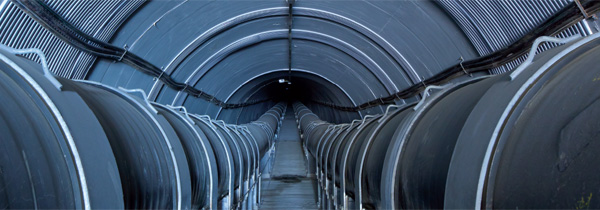
Snam intends to contribute actively to the creation of a gas hub system in Southern Europe, turning Italy into not just a gas consumer, but also a gas transit country
During the last 40 years, European consumption of natural gas has increased 19-fold and now accounts for about one third of the primary consumption of fossil energy in OECD Europe (understood as the original 15 countries, plus the Czech Republic, Hungary, Iceland, Norway, Poland, Slovakia, Switzerland and Turkey).
Historically, satisfying this demand has been possible due to rapid growth in gas production in areas neighbouring Europe – the North Sea, Russia and North Africa – connected to consumer markets mainly through a tight network of high-pressure gas pipelines that have now attained overall development of approximately 190,000 kilometres, of which more than 100,000 are concentrated between France, Germany and Italy. Italy is also a gas producer, having produced 8.03 billion cubic metres in 2011. The fact that domestic demand totalled 77.84 billion cubic metres last year means that Italy, like all the other OECD Europe states, except Norway and the Netherlands, is dependent on gas imports.
Between 2001 and 2008, various geopolitical and economic factors, including competition for energy resources due to the growth of emerging countries, resulted in a need for Western countries, and in particular European countries, to stabilise the supply scenario on world markets, which, just a few years previously, had seen them in a privileged position in terms of the possibility of purchasing and stockpiling their own supplies. The main driver for pursuing this objective was identified by the European Union as the development of a more flexible and competitive European market, in which transportation and distribution infrastructure networks can be developed independently of the contractual sales dynamics of the major integrated operators. The Third Energy Package was issued in 2009 in response to this.
Thanks to its geographical location and due to the development of transportation infrastructure and reverse flow technology, Italy can seize this opportunity, undergoing a transformation from consumer country to transit country, thus creating the conditions for playing a strategic role as Mediterranean Europe’s gas hub.
An agreement for the European maxi-network
In January 2012 Snam S.p.A. and Fluxys G S.A. signed an agreement for the evaluation of future joint strategies aimed at seizing potential opportunities for development in the European gas sector. The agreement involves natural gas transportation, storage and regasification activities, through projects designed to strengthen supply flexibility and security in relation to current European infrastructure. The initiatives also involve two-way transport flows, in line with the recommendations and provisions of the European Third Directive adopted by the EU Council and Parliament for an integrated gas market in order to promote cross-border flows and connect the major gas exchange infrastructure in North-Western and Southern Europe.
Fluxys G is the top Belgian operator and the gas hub for Northern Europe. Through its subsidiary, Fluxys S.A., it builds and manages natural gas transportation and storage infrastructure and liquefied natural gas terminals in Belgium.
For detailed information on the content of the agreement, please see the 2011 financial report.
INVESTMENTS AND NETWORK DEVELOPMENT

For Snam, opportunities for pursuing strategic goals are strongly tied to the possibility of investing economic resources in network expansion and improvement projects. Snam’s investments are focused on the procurement of goods, services and technologies and are currently spread evenly throughout almost all the different Italian regions, resulting in important economic growth factors.
The Snam plan for the 2012-2015 four-year period provides for investments in all sectors in the amount of €6.7 billion at consolidated level:
- the investment in the transportation sector is intended to increase transportation capacity both by extending the network and by increasing installed capacity at the gas compression stations;
- the investment in storage is geared primarily toward increasing capacity by expanding existing fields and creating new storage fields;
- the investment in distribution is aimed partly at network maintenance and development, increasing kilometres of new piping and replacing iron networks, and partly at the development of new distributed gas metering systems.
During 2011, almost €1.6 billion in investments were made, of which approximately 73% were with incentive-based remuneration consistent with ARG/gas Resolution 119/10 issued by the Authority for Electricity and Gas.
MAIN DEVELOPMENT PROJECTS IN PROGRESS
| Download XLS (21 kB) |
|
NORTH |
|
|
CENTRE |
|
|
SOUTH AND ISLANDS |
|




